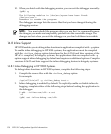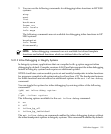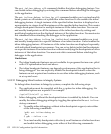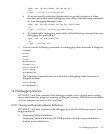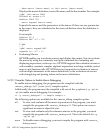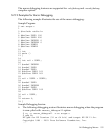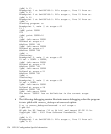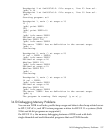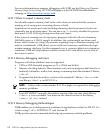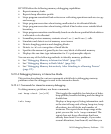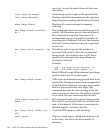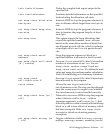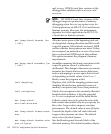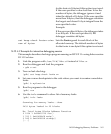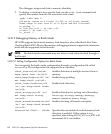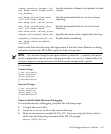
For more information on memory debugging with WDB, see the Debugging Dynamic
Memory Usage Errors Using HP WDB whitepaper at the HP WDB Documentation
webpage at: http://www.hp.com/go/wdb.
14.10.1 When to suspect a memory leak
You should suspect a memory leak in the code when you notice that the system is
running out of swap space or running slower, or both.
Applications or non-kernel code (including daemons) that have memory leaks can
eventually use up all swap space. You can run top(1) to verify whether the process
data space (SIZE, RES) is growing more than you expect.
If the system is running out of swap space, programs will fail with out-of-memory
(ENOMEM) errors or SIGBUS signals. In addition, the system might run slower and
slower until it comes to a stop; all processes requiring swap to continue running will
wait for it indefinitely. GDB allows you to catch out-of-memory conditions through
runtime memory checking. Use the command catch nomem to detect out-of-memory
conditions. GDB will stop whenever malloc returns NULL and allows you to look at
the current context.
14.10.2 Memory debugging restrictions
Programs with these attributes are not supported:
• CMA or DCE threaded programs on 11.x (32-bit and 64-bit)
• Memory checking features. These features work only in programs that directly or
indirectly call malloc, realloc, free, mmap, or munmap from the standard C library
libc.sl.
• Programs that link the archive version of the standard C library, libc.a, or the
core library, libcl.a, on HP-UX 11.x
NOTE: Linker with version number B.11.19 or higher is required for debugging
memory problems.
• From HP WDB 5.7 onwards, the archive version of the run time check library,
librtc.a, is not available. You must use the shared version of the library,
librtc.[sl|so], instead.
14.10.3 Memory Debugging Methodologies
WDB enables you to debug memory problems in applications written for HP-UX 11.x
or later using C, aC++, FORTRAN 77, and Fortran 90.
WDB provides several commands that help expose memory-related problems.
158 HP-UX Configuration-Specific Information



